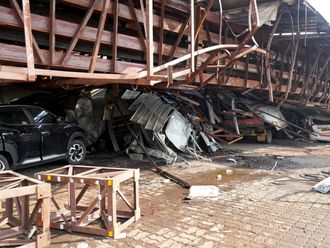London: A dagger entombed with King Tutankhamun was made with iron from a meteorite, a new analysis on the metal composition shows.
In 1925, archaeologist Howard Carter found two daggers, one iron and one with a blade of gold, within the wrapping of the teenage king, who was mummified more than 3,300 years ago. The iron blade, which had a gold handle, rock crystal pommel and lily and jackal-decorated sheath, has puzzled researchers in the decades since Carter’s discovery: ironwork was rare Italian and Egyptian researchers analysed the metal with an x-ray fluorescence spectrometer to determine its chemical composition, and found it had high nickel content, along with cobalt, which “strongly suggests an extraterrestrial origin”. They compared the composition to known meteorites within 2,000km around the Red Sea coast of Egypt and found similar levels in one meteorite.
That meteorite, named Kharga, was found 240km west of Alexandria, at the seaport city of Mersa Matruh, which in the age of Alexander the Great — the fourth century BC — was known as Amunia.
The researchers published their findings on Tuesday in the journal Meteoritics & Planetary Science.
Although people have worked with copper, bronze and gold since 4,000BC, ironwork came much later, and was rare in ancient Egypt. In 2013, nine blackened iron beads, excavated from a cemetery near the Nile in northern Egypt, were found to have been beaten out of meteorite fragments and a nickel-iron alloy. The beads are far older than the young pharaoh, dating to 3,200BC.
The nine beads were excavated in 1911 in a predynastic cemetery near Al Gerzeh in Egypt, and are now among objects at the Petrie Museum, part of University College London, which has a world-renowned Egyptian collection, including quantities of exquisite jewellery. The iron beads — the metal from the meteorites is actually an iron-nickel alloy, with other elements including cobalt and phosphorus that helped prove its source — were made using a completely different technique from the other beads in the necklace, gold and gemstones which were cast, carved or drilled.
The fact that the iron beads were combined with such precious materials proves that although the ancient jewellers could not have known the true source of the strange metal that fell from the sky, it was highly valued.
The beads were heavily corroded when they were excavated from a grave in 1911, in a predynastic cemetery near Al Gerzeh in Egypt. However, the team led by Professor Thilo Rehren, director of the University College London branch in Qatar, an expert on the archaeology of metal working, scanned them with beams of neutrons and gamma-rays, which revealed not only that they really were made from meteorite fragments but also how they were made.
“The shape of the beads was obtained by smithing and rolling, most likely involving multiple cycles of hammering, and not by the traditional stone-working techniques such as carving or drilling which were used for the other beads found in the same tomb,” Rehren said. He was impressed at the ancient Egyptians’ skills, which he said showed an “advanced understanding” of the material they were using.
The researchers also stood with a hypothesis that ancient Egyptians placed great importance on rocks falling from the sky. They suggested that the finding of a meteorite-made dagger adds meaning to the use of the term “iron” in ancient texts, and noted around the 13th-century BC, a term “literally translated as ‘iron of the sky’ came into use … to describe all types of iron”.
“The introduction of the new composite term suggests that the ancient Egyptians were aware that these rare chunks of iron fell from the sky already in the 13th [century] BCE, anticipating Western culture by more than two millennia,” the researchers wrote.
Egyptologist Joyce Tyldesley, of the University of Manchester, similarly argued that ancient Egyptians would have revered celestial objects that had plunged to earth.
“The sky was very important to the ancient Egyptians,” she told Nature, of her work on the meteoritic beads. “Something that falls from the sky is going to be considered as a gift from the gods.”
The high quality of the blade suggests that Tutankhamun, who lived during the latest stage of the Bronze Age, was supported by ironworkers who were skilled despite the relative rarity of the material.
The blade may not be the only item derived from falling rocks in Tut’s tomb.
In 2006, an Austrian astrochemist proposed that an unusual yellowish gem, shaped as a scarab in King Tut’s burial necklace, is actually glass formed in the heat of a meteorite crashing into sand.
“It would be very interesting to analyse more pre-Iron Age artefacts such as other iron objects found in King Tut’s tomb,” Daniela Comelli, of the physics department at Milan Polytechnic, told Discovery News. “We could gain precious insights into metal-working technologies in ancient Egypt and the Mediterranean.”
Austrian astrochemist Christian Koeberl had established that the glass had been formed at a temperature so hot that there could be only one known cause: a meteorite impacting with Earth. And yet, there were no signs of a suitable impact crater, even in satellite images.
American geophysicist John Wasson is another scientist interested in the origins of the glass. He suggested a solution that came directly from the forests of Siberia.
“When the thought came to me that it required a hot sky, I thought immediately of the Tunguska event,” he told Horizon.
In 1908, a massive explosion flattened 80 million trees in Tunguska, Siberia.
Although there was no sign of a meteorite impact, scientists now think an extraterrestrial object of some kind must have exploded above Tunguska. Wasson wondered if a similar aerial burst could have produced enough heat to turn the ground to glass in the Egyptian desert.
The first atomic bomb detonation, at the Trinity site in New Mexico in 1945, created a thin layer of glass on the sand. But the area of glass in the Egyptian desert is vastly bigger.
Whatever happened in Egypt must have been much more powerful than an atomic bomb.
A natural airburst of that magnitude was unheard of until, in 1994, scientists watched as comet Shoemaker-Levy collided with Jupiter. It exploded in the Jovian atmosphere, and the Hubble telescope recorded the largest incandescent fireball ever witnessed rising over Jupiter’s horizon.
Mark Boslough, who specialises in modelling large impacts on supercomputers, created a simulation of a similar impact on Earth.
The simulation revealed that an impactor could indeed generate a blistering atmospheric fireball, creating surface temperatures of 1,800 degrees Celsius, and leaving behind a field of glass.
“What I want to emphasise is that it is hugely bigger in energy than the atomic tests,” said Boslough. “Ten thousand times more powerful.”












